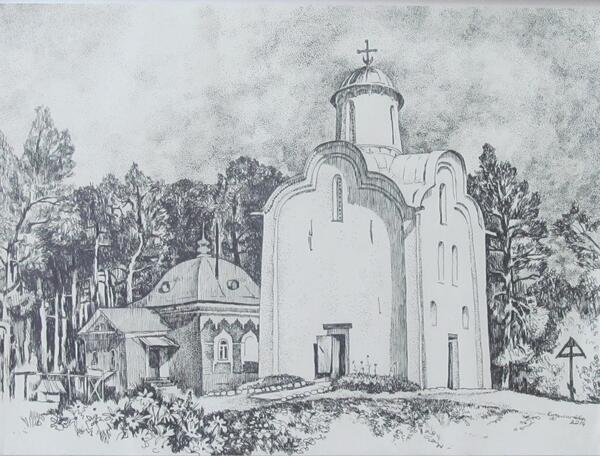Olga Leonidovna Kuzmichyova was born in 1983 in the Murmansk region, in the town of Kovdor, and decided early in her life to devote herself to the world of art. From the age of six, she attended a children’s art school, and in 2011 she began studying to become a designer at Yaroslav-the-Wise Novgorod State University. She honed her skills in the art studios of Eduard Nikolayevich Ivanov and Anatoly Sergeyevich Mishchenko (2002–2007). At the same time, in 2003–2005, she was engaged in preparatory courses at the Department of Graphics at the Repin State Academic Institute of Painting, Sculpture and Architecture in St. Petersburg, developing her own style.
Having participated in exhibitions, she continued to improve her skills in graphic arts, using a variety of techniques and methods of this art form.
Among the artist’s favorite subjects is the village, the simple beauty of rural life, nature, and scenes of everyday life, as well as ancient architectural monuments that are decaying and disappearing from the face of the earth. Olga Leonidovna worries that “in the pursuit of improving our life, we lose touch with history”. Thus, she seeks to capture and preserve the signs of fleeting time.
Therefore, each sketch of the artist turns into a small cohesive story full of keen observations and philosophical thought.
It is expressed in the presented graphic work depicting the ancient Novgorod Church of the Nativity of the Theotokos on Peryn, better known as the Peryn Skete.
In pagan times, an idol of Perun, god of Thunder, stood on Peryn, a peninsula near Novgorod. The remains of the pagan shrine complex were discovered in the mid-20th century during archaeological excavations led by Artemy Vladimirovich Artsikhovsky.
In 989, after the Christianization of Novgorod, the temple was destroyed, and five years later a wooden church of the Nativity of the Theotokos was erected in its place. Perhaps the first monastery was founded at the same time, but burned down in 1386.
The new Peryn Skete existed from the 14th century until 1764, when, in connection with the church and land reform of Catherine II, many monasteries were ordered to be abolished.
The skete owes its revival in the 19th century to the efforts of Archimandrite Photius (Spassky) and the support of his spiritual daughter, Countess Anna Alekseyevna Orlova-Chesmenskaya. Since that time, the monastery flourished until the beginning of the 20th century, when it was again closed and turned into a building for common use.
Nowadays, the skete functions as a men’s monastery, attributed to the St. George’s Monastery.
Having participated in exhibitions, she continued to improve her skills in graphic arts, using a variety of techniques and methods of this art form.
Among the artist’s favorite subjects is the village, the simple beauty of rural life, nature, and scenes of everyday life, as well as ancient architectural monuments that are decaying and disappearing from the face of the earth. Olga Leonidovna worries that “in the pursuit of improving our life, we lose touch with history”. Thus, she seeks to capture and preserve the signs of fleeting time.
Therefore, each sketch of the artist turns into a small cohesive story full of keen observations and philosophical thought.
It is expressed in the presented graphic work depicting the ancient Novgorod Church of the Nativity of the Theotokos on Peryn, better known as the Peryn Skete.
In pagan times, an idol of Perun, god of Thunder, stood on Peryn, a peninsula near Novgorod. The remains of the pagan shrine complex were discovered in the mid-20th century during archaeological excavations led by Artemy Vladimirovich Artsikhovsky.
In 989, after the Christianization of Novgorod, the temple was destroyed, and five years later a wooden church of the Nativity of the Theotokos was erected in its place. Perhaps the first monastery was founded at the same time, but burned down in 1386.
The new Peryn Skete existed from the 14th century until 1764, when, in connection with the church and land reform of Catherine II, many monasteries were ordered to be abolished.
The skete owes its revival in the 19th century to the efforts of Archimandrite Photius (Spassky) and the support of his spiritual daughter, Countess Anna Alekseyevna Orlova-Chesmenskaya. Since that time, the monastery flourished until the beginning of the 20th century, when it was again closed and turned into a building for common use.
Nowadays, the skete functions as a men’s monastery, attributed to the St. George’s Monastery.





